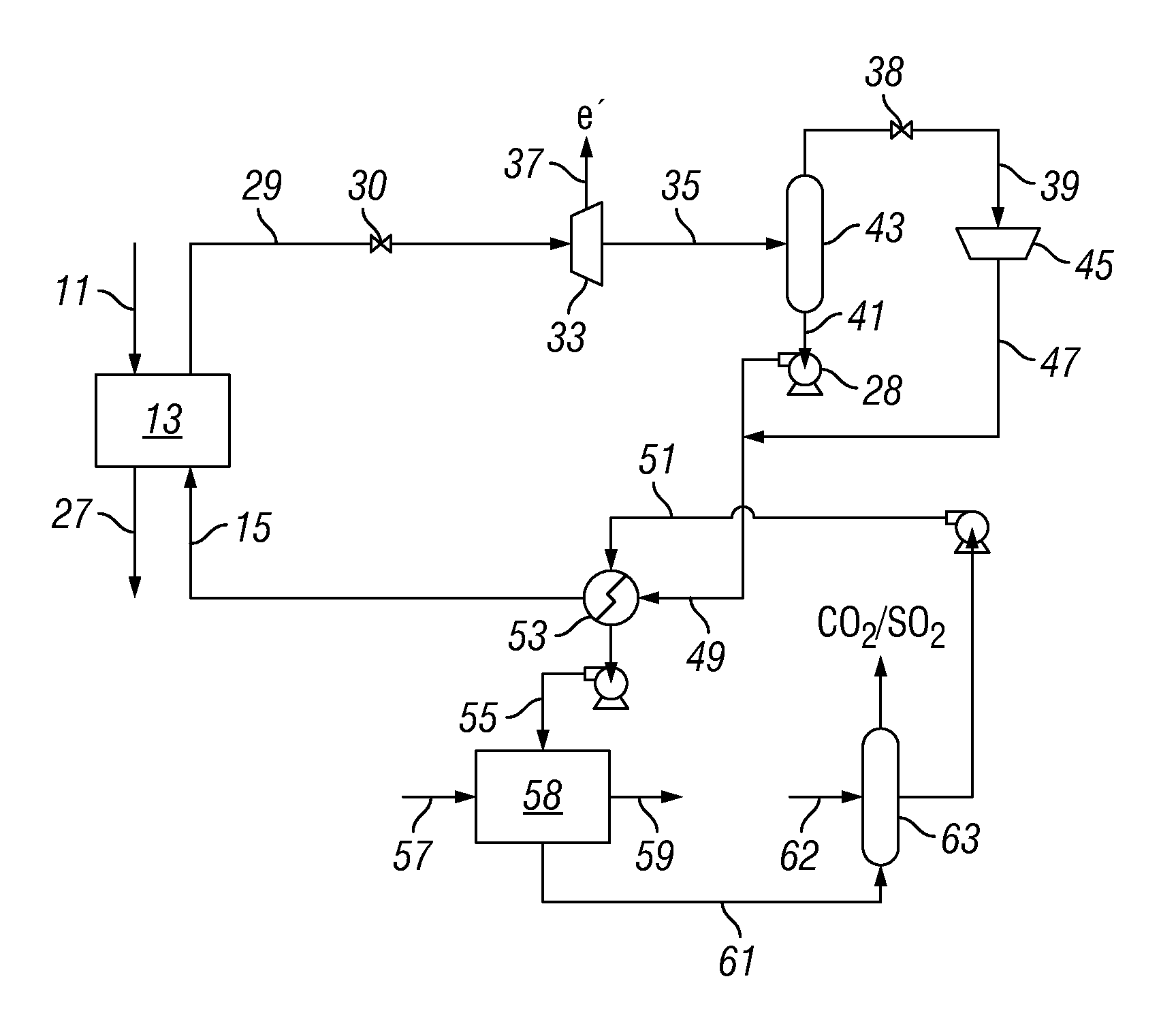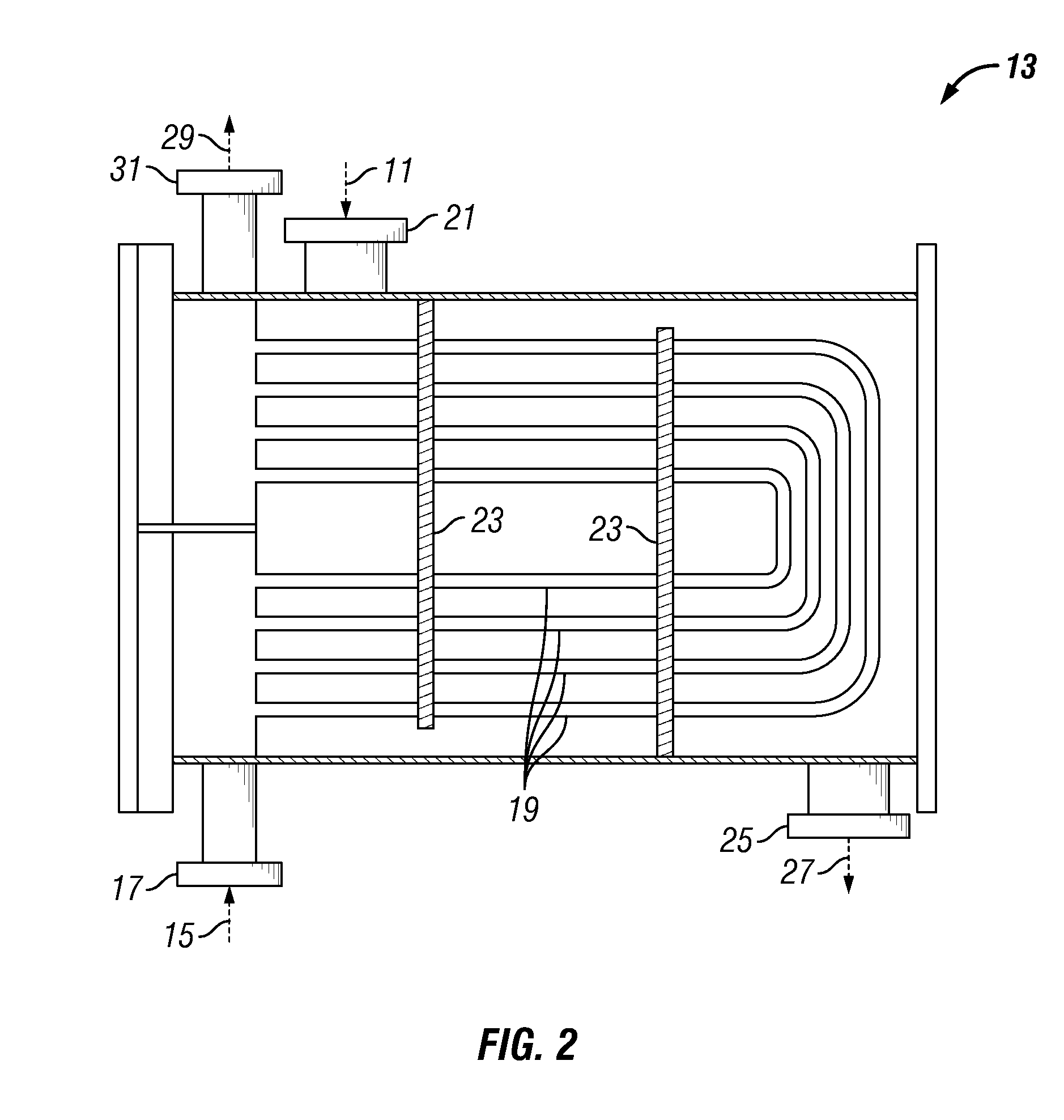System and process for generation of electrical power
a technology of electrical power generation and process, applied in the direction of steam engine plants, machines/engines, mechanical equipment, etc., can solve the problems of significant quantities of carbon dioxide, the electrical power generation system and process of steam-based thermal to electrical power is relatively inefficient, and the efficiency of nuclear power plants is less than standard fossil fuel plants
- Summary
- Abstract
- Description
- Claims
- Application Information
AI Technical Summary
Benefits of technology
Problems solved by technology
Method used
Image
Examples
example 1
Illustrative Example 1
USC CFB Plant with Single Re-Heat Steam Design and Integrated Second Fluid Power Cycle
[0133]A design study was prepared based on thermodynamic calculations of a method and system for producing electrical power using a first power cycle utilizing water / steam as a working fluid and a second power cycle utilizing carbon dioxide as a working fluid, where the method and system were in accordance with the present invention. In the first power cycle, a coal-fired heat source was utilized to produce ultra-supercritical steam for generation of electrical power followed by an integrated second fluid power cycle utilizing carbon dioxide as a working fluid.
[0134]In the first power cycle, the coal-fired steam turbine driven generator portion of the design study of Illustrative Example 1 replicated the design study of the USC CFB Plant of nominally 400 MWe capacity described in Comparative Example 1 above with the exception that: (a) the low pressure steam turbine was elimin...
example 2
Illustrative Example 2
USC CFB Plant with Single Re-Heat Steam Design and Integrated Second Fluid Power Cycle Including Power Extraction from Flue Gas
[0166]A design study was prepared based on thermodynamic calculations of a method and a system for producing electrical power using a first power cycle utilizing water / steam as the working fluid and a second power cycle utilizing carbon dioxide as a working fluid, where the method and system were in accordance with the present invention. In the first power cycle, a coal-fired heat source was utilized to produce ultra-supercritical steam for generation of electrical power followed by an integrated second fluid power cycle utilizing carbon dioxide as a working fluid. Power extracted from flue gas produced by burning coal was included in the power produced in the second power cycle.
[0167]In the first power cycle, the coal-fired steam turbine driven generator portion of the design study of Illustrative Example 2 replicated the design study ...
example 3
Illustrative Example 3
USC CFB Plant with Single Re-Heat Steam Design and Integrated Second Fluid Power Cycle including Power Extraction from Flue Gas—Flue Gas Heat Exchanger in Series Flow configuration with Steam / Water Condenser
[0220]In Illustrative Example 3, the design study of Illustrative Example 2 was modified in one respect—the flue gas heat exchanger was placed in a series flow configuration with the steam condenser, where liquid pressurized carbon dioxide having a temperature of from 0 to 10° C. and a pressure of 30 MPa was provided to the flue gas heat exchanger, and the carbon dioxide stream exiting the flue gas heat exchanger was provided to the steam condenser to cool and condense liquid water from the steam provided to the steam condenser. The heated supercritical carbon dioxide exiting the steam condenser was then expanded in the second fluid power cycle. The system and method of the design study prepared in Illustrative Example 3 were in accordance with the system an...
PUM
 Login to View More
Login to View More Abstract
Description
Claims
Application Information
 Login to View More
Login to View More - R&D
- Intellectual Property
- Life Sciences
- Materials
- Tech Scout
- Unparalleled Data Quality
- Higher Quality Content
- 60% Fewer Hallucinations
Browse by: Latest US Patents, China's latest patents, Technical Efficacy Thesaurus, Application Domain, Technology Topic, Popular Technical Reports.
© 2025 PatSnap. All rights reserved.Legal|Privacy policy|Modern Slavery Act Transparency Statement|Sitemap|About US| Contact US: help@patsnap.com



